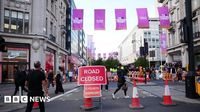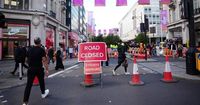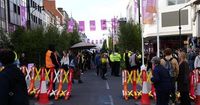On Sunday, September 21, 2025, a half-mile stretch of London’s Oxford Street transformed into a pedestrian paradise, as vehicles were banned between Oxford Circus and Orchard Street from noon to 8pm. The event, aptly named "This Is Oxford Street," wasn’t just a festive day out—it marked a pivotal moment in the city’s ongoing debate over the future of one of the world’s busiest shopping streets. According to the BBC, Mayor of London Sadiq Khan declared, "Today is a glimpse to what the future could be like, where this is a place where people can walk. It increases footfall. It increases spend, (it will be a) great place to shop, to do leisure, but also have outdoor events."
The mayor’s ambitions go well beyond a single afternoon. Sir Sadiq Khan wants to permanently ban vehicles from a 0.7-mile stretch of Oxford Street, running from Oxford Circus to Marble Arch, with the potential for expanding the pedestrian zone towards Tottenham Court Road. This vision, he argues, could "rescue this street" from what he called "managed decline"—a trend driven by the rise of online shopping, out-of-town retail centers, and the lingering aftershocks of the pandemic. As he told the PA news agency, "You’ve seen a situation where more and more people are shopping online or going to out-of-town centres, shopping centres, high-profile shops have left Oxford Street, and the pandemic was a real body blow to this street."
Sunday’s car-free trial was more than a traffic experiment; it was a lively celebration of what Oxford Street could become. The space filled with live music, art installations, food stalls, and even a literary festival, giving half a million daily visitors a taste of a more vibrant, walkable city center. As reported by LBC, the mayor described the event as "a landmark, free event open for everyone and will showcase the nation’s high street as you have never seen it before, offering a glimpse of what it could look like in the future."
But not everyone is convinced. Concerns have been raised about the impact on accessibility for those with mobility issues, as well as the potential for increased congestion on smaller side streets. Conservative councillor for Westminster, Tim Barnes, warned the BBC, "It’s going to be damaging to local businesses and local residents. We’re going to see traffic that normally goes down Oxford Street. Not private cars—they’ve already been banned—but emergency vehicles, buses, delivery vehicles, pushed onto the tiny side streets that really can’t take it."
The Soho Society and others have echoed worries about access for people with disabilities or those carrying heavy shopping. The mayor, for his part, acknowledged these concerns, saying, "I fully understand the minority of residents who raised concerns over congestion and accessibility, and the authority had consulted residents." He added, "We’re going to carry on not just working with residents and the council, but working with retailers, landowners and others to make sure we can return this street to its previous glory."
Many pedestrians, though, seemed delighted by the change. Grace and Tom Brown, interviewed by the BBC, were enthusiastic: "I would have it like this all the time," said Grace. Tom added, "I think it would really encourage all the businesses. I think people are put off by how busy it is. I think if people could come and chat and stroll about, and you feel safe, that would be great." Another passer-by, Kish Sha, told the BBC, "Yeah it’s really made my day having this space to walk through. There’s so much razzmatazz. It makes sense to keep it permanently for the sheer number of people that come through here. I’m sure bus services and emergency vehicles have other routes they can come through quickly in the area."
There’s data to back up the optimism. According to Living Streets’ "Pedestrian Pound" research, investing in walkable environments can help reverse high street decline. Their studies found that in 14 Spanish cities, shops in pedestrianised areas generated higher sales than those in non-pedestrianised zones. In Seoul, Korea, the creation of the 6.3km Gyeongui Line Forest Park increased local business sales by 10-12% relative to businesses further away. Closer to home, a comparison across ten London streets revealed a 17% reduction in retail vacancies in areas that prioritized pedestrian accessibility. And in Shrewsbury, weekend pedestrianisation during the pandemic was so popular it became permanent, with sales rising by 14% and pedestrianised areas seeing growth 25 percentage points higher than non-pedestrianised ones.
But the benefits of pedestrianisation go beyond economics. Living Streets’ director Tanya Braun argued in the Big Issue that walkable streets enhance physical and mental wellbeing, boost social cohesion, and foster a sense of community. "The high street can be a lifeline for those who need social interaction, a place to visit, improve mental health and feel part of a community," she wrote. "Walking increases the opportunities for engaging with other people and there is a strong association between the walkability of an area and its sense of community."
Still, the path to a permanently car-free Oxford Street is not straightforward. A previous attempt to pedestrianise the area in 2018 was blocked by the then-Conservative-run Westminster City Council. This time, the mayor’s proposals hinge on securing government permission to establish a new Mayoral Development Corporation, which would grant the necessary planning powers. The goal is to have this body in place by early 2026, with detailed consultations on traffic plans set for later in 2025.
Advocates argue that Oxford Street’s transformation could be a catalyst for wider changes across London’s West End. Braun emphasized that "the problems pedestrians face are not confined to Oxford Street, so we need the pedestrianisation to become a catalyst for wider changes across the West End, so Oxford Street doesn’t feel like an island surrounded by hostile streets." She also stressed the need for inclusivity: "The street needs to be accessible to all, regardless of age or ability, so changes need to happen in consultation with disabled people."
For now, the one-day trial has ignited debate and imagination. Whether Oxford Street’s future will be car-free remains to be seen, but as the mayor put it, "(Today) will go down in history, in my view, as the day the fight back began to rescue this street." With the fate of London’s most iconic shopping destination hanging in the balance, the conversations sparked by Sunday’s event will likely shape the city’s streetscapes for years to come.


